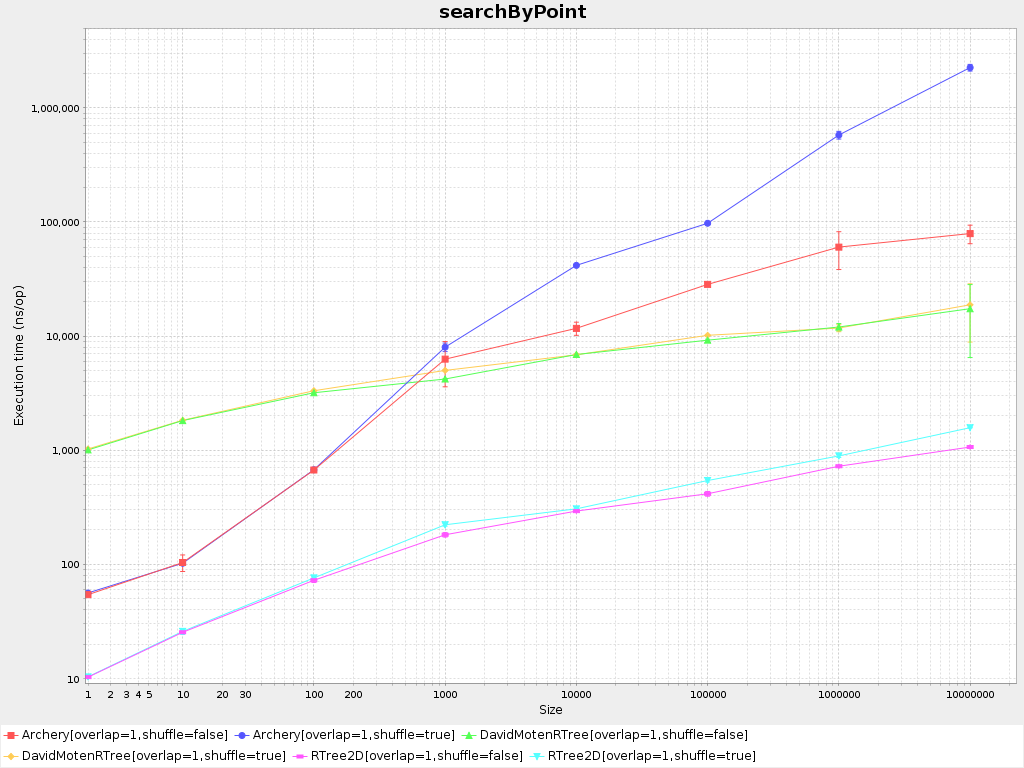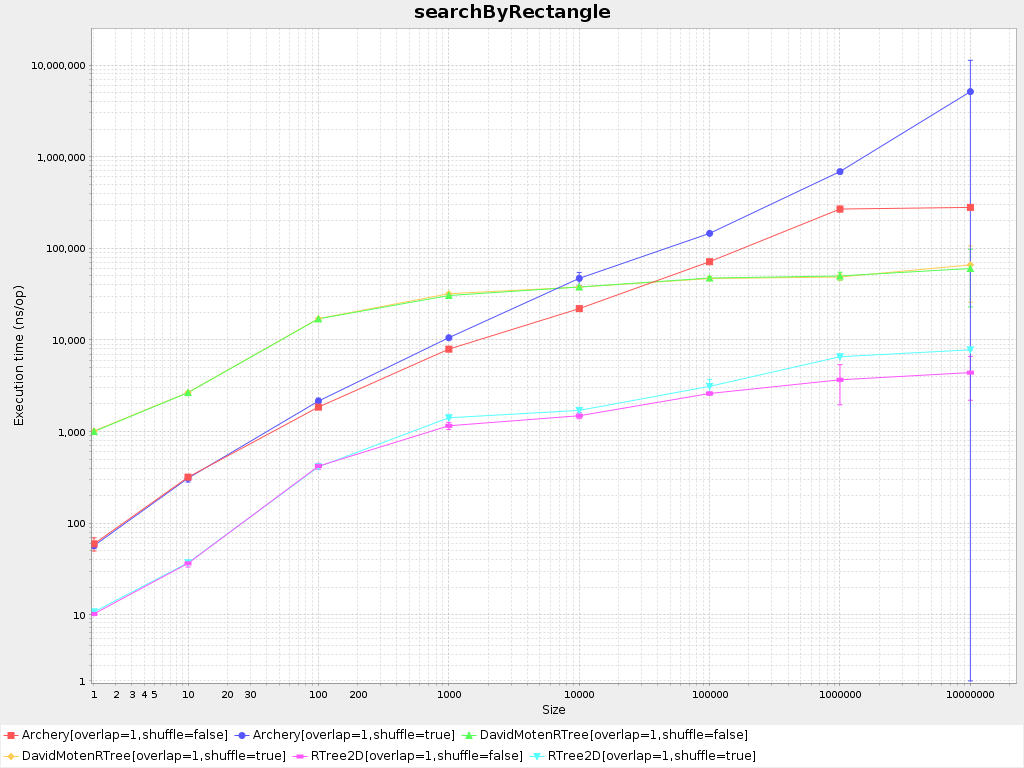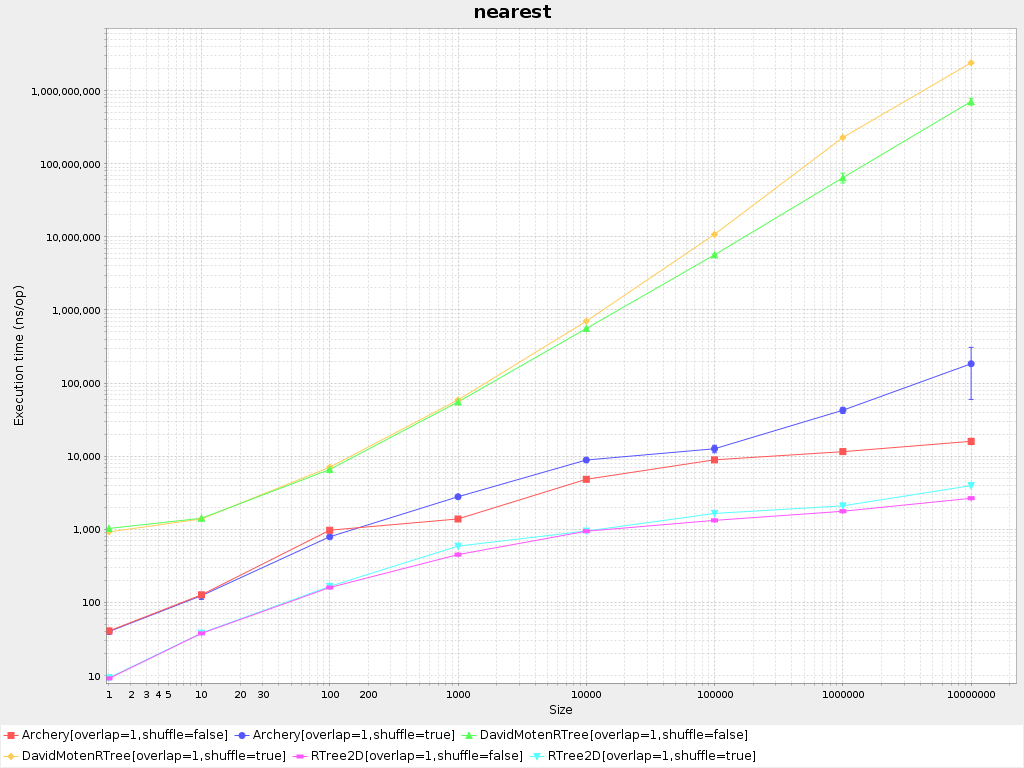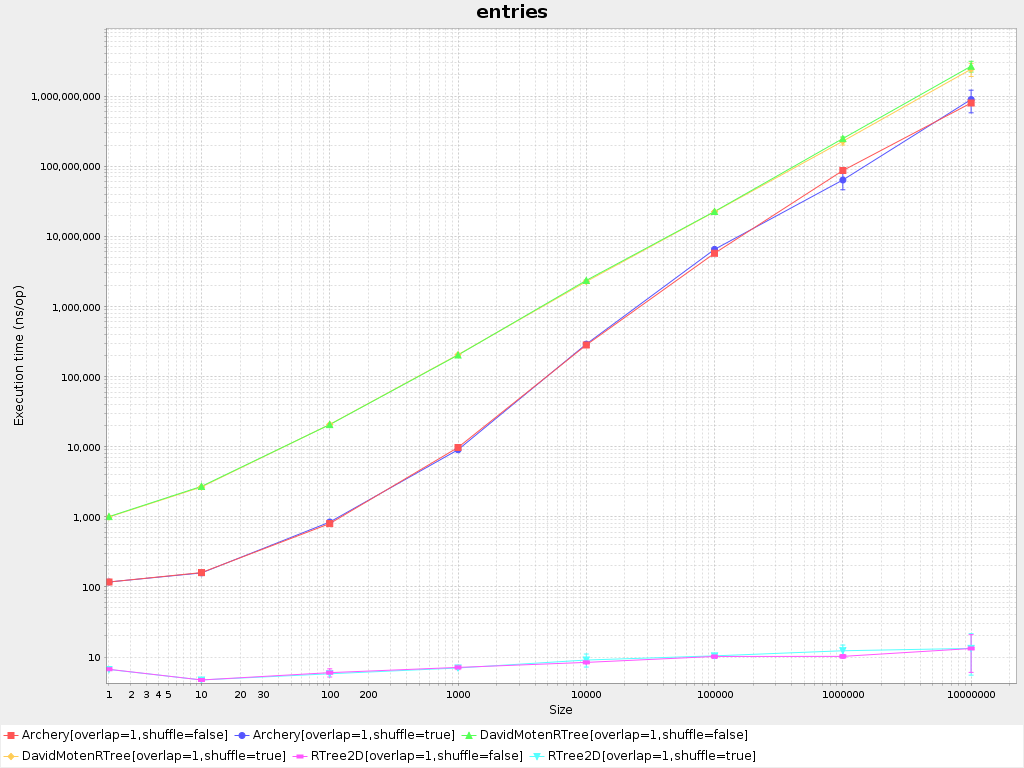RTree2D is a 2D immutable R-tree with STR (Sort-Tile-Recursive) packing for ultra-fast nearest and intersection queries.
Main our requirements was:
- efficiency: we wanted the R-Tree to be able to search millions of points efficiently even in case of highly overlapped entries, also, we needed to be able to quickly rebuild R-tries with a per minute rate producing minimum pressure on GC
- immutability: different threads needed to be able to work with the same R-tree without problems, at the same time some thread can build a new version of the R-tree reusing immutable entries from the previous version
To archive these goals we have used:
- STR packing that is a one of the most efficient packing method which produces balanced R-tree
- a memory representation and access patterns to it which are aware of a cache hierarchy of contemporary CPUs (while it is not a final version and can be improved further soon)
- an efficient TimSort version of merge sorting from Java which minimize access to memory
- efficient implementations of search functions with minimum of virtual calls and allocations (there are versions with zero allocations)
The library is published to JCenter, so please add a resolver for it in your build.sbt file or ensure that it is
already added:
resolvers += Resolver.jcenterRepoAdd the library to a dependency list:
libraryDependencies += "com.sizmek.rtree2d" %% "core" % "0.4.0"Entries of R-tree are represented by RTreeEntry instances which contains payload and 4 coordinates of the minimum
bounding rectangle (MBR) for it.
Add import, create entries, build an R-tree from them, and use it for search a nearest entry or search intersections by point or rectangle requests:
import com.sizmek.rtree2d.core._
import EuclideanPlane._
val box1 = entry(1.0f, 1.0f, 2.0f, 2.0f, "Box 1")
val box2 = entry(2.0f, 2.0f, 3.0f, 3.0f, "Box 2")
val entries = Seq(box1, box2)
val rtree = RTree(entries)
assert(rtree.entries == entries)
assert(rtree.nearest(0.0f, 0.0f) == Some((1.4142135f, box1)))
assert(rtree.nearest(0.0f, 0.0f, 1.0f) == None)
assert(rtree.nearest(1.5f, 1.5f) == Some((0.0f, box1)))
assert(rtree.searchAll(0.0f, 0.0f) == Nil)
assert(rtree.searchAll(1.5f, 1.5f) == Seq(box1))
assert(rtree.searchAll(2.5f, 2.5f) == Seq(box2))
assert(rtree.searchAll(2.0f, 2.0f) == Seq(box1, box2))
assert(rtree.searchAll(2.5f, 2.5f, 3.5f, 3.5f) == Seq(box2))
assert(rtree.searchAll(1.5f, 1.5f, 2.5f, 2.5f).forall(entries.contains))RTree2D can be used for indexing spherical coordinates, where X-axis is used for latitudes, and Y-axis for longitudes in degrees. Result distances are in kilometers:
import com.sizmek.rtree2d.core._
import SphericalEarth._
val city1 = entry(50.0614f, 19.9383f, "Kraków")
val city2 = entry(50.4500f, 30.5233f, "Kyiv")
val entries = Seq(city1, city2)
val rtree = RTree(entries, nodeCapacity = 4/* the best capacity for nearest queries for spherical geometry */)
assert(rtree.entries == entries)
assert(rtree.nearest(0.0f, 0.0f) == Some((5879.9897f, city1)))
assert(rtree.nearest(50f, 20f, 1.0f) == None)
assert(rtree.nearest(50f, 20f) == Some((8.126432f, city1)))
assert(rtree.searchAll(50f, 30f, 51f, 31f) == Seq(city2))
assert(rtree.searchAll(0f, -180f, 90f, 180f).forall(entries.contains))Used spherical model of the Earth with the mean radius allows to get +0.2% accuracy on poles, -0.1% on the equator, and less than ±0.05% on medium latitudes. Precision of 32-bit float number allows to locate points and calculate distances with an error ±0.5 meters.
Please, check out Scala docs in sources and tests. for other functions which allows no allocations and fast exit from search requests.
Charts below are latest results of benchmarks which compare RTree2D with Archery and David Monten's rtree libraries using JDK 8 on the following environment: Intel® Core™ i7-7700HQ CPU @ 2.8GHz (max 3.8GHz), RAM 16Gb DDR4-2400, Ubuntu 18.04, latest versions of Oracle JDK 8.
Main metric tested by benchmarks is an execution time in nanoseconds. So lesser values are better. Please, check out the Run benchmarks section bellow how to test other metrics like allocations in bytes or number of some CPU events.
Benchmarks have the following parameters:
sizeis a number of entries in the R-treeshuffleis a flag to turn on/off shuffling of entries before R-tree buildingoverlapis a size of entries relative to interval between them
The apply benchmark tests building of R-tries from a sequence of entires.
The searchByPoint benchmark tests requests that search entries with intersects with the specified point.
The searchByRectangle benchmark tests requests that search entries with intersects with the specified rectangle that
can intersect with up to 100 entries.
The nearest benchmark tests search an entry of the R-tree that a nearest to the specified point.
The entries benchmark tests returning of all entries that are indexed in the R-tree.
The update benchmark tests rebuild of R-tree with removing of +10% entries and adding of +10% another entries to it.
Charts with their results are available in subdirectories (each for different value of overlap parameter) of the docs directory.
To compile, run tests, check coverage for different Scala versions use a command:
sbt clean +coverage +test +coverageReport +mimaReportBinaryIssuesBenchmarks are developed in the separated module using Sbt plugin for JMH tool.
Feel free to modify benchmarks and check how it works with your data, JDK, and Scala versions.
To see throughput with allocation rate run benchmarks with GC profiler using the following command:
sbt -no-colors clean 'benchmark/jmh:run -prof gc -rf json -rff rtries.json .*'It will save benchmark report in benchmark/rtries.json file.
Results that are stored in JSON can be easy plotted in JMH Visualizer by drugging & dropping
of your file(s) to the drop zone or using the source or sources parameters with an HTTP link to your file(s) in the
URLs: http:https://jmh.morethan.io/?source=<link to json file> or http:https://jmh.morethan.io/?sources=<link to json file1>,<link to json file2>.
Also, there is an ability to run benchmarks and visualize results with a charts command. It adds -rf and -rff
options to all passes options and supply them to jmh:run task, then group results per benchmark and plot main score
series to separated images. Here is an example how it can be called for specified version of JVM, value of the overlap
parameter, and patterns of benchmark names:
sbt 'charts -jvm /usr/lib/jvm/java-8-oracle/bin/java -p overlap=1 .*apply.* .*search.*'Results will be places in a cross-build suffixed subdirectory of the benchmark/target directory in *.png files:
$ ls benchmark/target/scala-2.12/*.*n*
benchmark/target/scala-2.12/apply.png
benchmark/target/scala-2.12/searchByPoint.png
benchmark/target/scala-2.12/benchmark.jsonPublish to local Ivy repo:
sbt publishLocalPublish to local Maven repo:
sbt publishM2For version numbering use Recommended Versioning Scheme that is used in the Scala ecosystem.
Double check binary and source compatibility, including behavior, and release using the following command (credentials are required):
sbt releaseDo not push changes to github until promoted artifacts for the new version are not available for download on jCenter to avoid binary compatibility check failures in triggered Travis CI builds.





